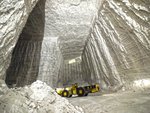Shabbat Table Talk from the desk of Rabbi Alexander Seinfeld
Here's a follow-up to last week's follow up to the Moral Compass question from two weeks ago...
This week's title refers to salt. Are you a plain Norton Table Salt kind of person, or are you a fancy pink Himalayan salt kind of person?
I can tell you why I personally jumped on the pink bandwagon for awhile.
- It's cool.
- It's reasonably priced on Amazon.
- It doesn't come from the polluted ocean.
The ocean has microplastics, heavy metals and who knows what.
I just discovered that our favorite Nori seaweed carries the California Prop 65 warning - it's likely tainted with lead or mercury.
The scariest thing about microplastics is that nobody has any idea if and how they may harm us - and now they're being found in all parts of the human body, including the brain.
We at least have a clue about the source of oceanic microplastic - much comes from the tire wear of 1,500,000,000 cars on the world's roads (the tires on your car are more than ¼ plastic).
But what about the microplastics they're now finding high in the Himalayas? And one study found that the Himalayan pinks rank worst among salts for microplastic contamination.
And just as bad - some Himalayan pink salts have lead and arsenic above the Prop 65 levels. Here's a full article by consumer activist Leah Segedie who tested them. She states: "The good news is no salt product came back with the equivalent levels that would require a Prop. 65 warning based on serving size per day."
And there's an additional issue: iodine - Himalayan salt, Trader Joe's boutique seasonings, salt in processed foods - none of those are iodized, and iodine deficiency is a real concern.
So what salt(s) to choose?
I'm happy to report that good ol' fashioned Morton iodized table salt has tested very favorably in terms of heavy metals. But no info on the microplastics. And the common critique of Morton salt is that:
Typical table salts such as Morton’s has been heavily processed, bleached and heated. This high heat changes the chemical structure of sodium chloride, transforming it into a state that is no longer natural and different from what our bodies are designed to digest and use. An additive called calcium silicate is then added to prevent clumping.
According to the principle "the less processed, the better," here are interesting options that I'm currently looking at....
Seasonello - from Sardinia (one of the Blue Zones) - iodized
Redmond Real Salt - from a Utah salt mine - not iodized
(BTW, if you use non-iodized salt, you can get your daily RDA from a couple glasses of milk, 12 or so ounces of Greek yogurt, or six eggs. Or a sheet of seaweed, if you can find any without the Prop 65 warning!)
Question for your table - Does this entire discussion really matter, or is it mere alarmism?
Shabbat Shalom
This week's title refers to salt. Are you a plain Norton Table Salt kind of person, or are you a fancy pink Himalayan salt kind of person?
I can tell you why I personally jumped on the pink bandwagon for awhile.
- It's cool.
- It's reasonably priced on Amazon.
- It doesn't come from the polluted ocean.
The ocean has microplastics, heavy metals and who knows what.
I just discovered that our favorite Nori seaweed carries the California Prop 65 warning - it's likely tainted with lead or mercury.
The scariest thing about microplastics is that nobody has any idea if and how they may harm us - and now they're being found in all parts of the human body, including the brain.
We at least have a clue about the source of oceanic microplastic - much comes from the tire wear of 1,500,000,000 cars on the world's roads (the tires on your car are more than ¼ plastic).
But what about the microplastics they're now finding high in the Himalayas? And one study found that the Himalayan pinks rank worst among salts for microplastic contamination.
And just as bad - some Himalayan pink salts have lead and arsenic above the Prop 65 levels. Here's a full article by consumer activist Leah Segedie who tested them. She states: "The good news is no salt product came back with the equivalent levels that would require a Prop. 65 warning based on serving size per day."
And there's an additional issue: iodine - Himalayan salt, Trader Joe's boutique seasonings, salt in processed foods - none of those are iodized, and iodine deficiency is a real concern.
So what salt(s) to choose?
I'm happy to report that good ol' fashioned Morton iodized table salt has tested very favorably in terms of heavy metals. But no info on the microplastics. And the common critique of Morton salt is that:
Typical table salts such as Morton’s has been heavily processed, bleached and heated. This high heat changes the chemical structure of sodium chloride, transforming it into a state that is no longer natural and different from what our bodies are designed to digest and use. An additive called calcium silicate is then added to prevent clumping.
According to the principle "the less processed, the better," here are interesting options that I'm currently looking at....
Seasonello - from Sardinia (one of the Blue Zones) - iodized
Redmond Real Salt - from a Utah salt mine - not iodized
(BTW, if you use non-iodized salt, you can get your daily RDA from a couple glasses of milk, 12 or so ounces of Greek yogurt, or six eggs. Or a sheet of seaweed, if you can find any without the Prop 65 warning!)
Question for your table - Does this entire discussion really matter, or is it mere alarmism?
Shabbat Shalom




No comments:
Post a Comment